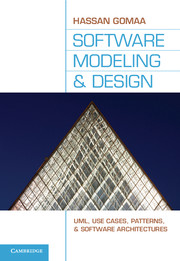Book contents
- Frontmatter
- Contents
- Preface
- Annotated Table of Contents
- Acknowledgments
- PART I Overview
- PART II Software Modeling
- PART III Architectural Design
- 12 Overview of Software Architecture
- 13 Software Subsystem Architectural Design
- 14 Designing Object-Oriented Software Architectures
- 15 Designing Client/Server Software Architectures
- 16 Designing Service-Oriented Architectures
- 17 Designing Component-Based Software Architectures
- 18 Designing Concurrent and Real-Time Software Architectures
- 19 Designing Software Product Line Architectures
- 20 Software Quality Attributes
- PART IV Case Studies
- Appendix A Catalog of Software Architectural Patterns
- Appendix B Teaching Considerations
- Glossary
- Answers to Exercises
- Bibliography
- Index
12 - Overview of Software Architecture
from PART III - Architectural Design
Published online by Cambridge University Press: 05 June 2012
- Frontmatter
- Contents
- Preface
- Annotated Table of Contents
- Acknowledgments
- PART I Overview
- PART II Software Modeling
- PART III Architectural Design
- 12 Overview of Software Architecture
- 13 Software Subsystem Architectural Design
- 14 Designing Object-Oriented Software Architectures
- 15 Designing Client/Server Software Architectures
- 16 Designing Service-Oriented Architectures
- 17 Designing Component-Based Software Architectures
- 18 Designing Concurrent and Real-Time Software Architectures
- 19 Designing Software Product Line Architectures
- 20 Software Quality Attributes
- PART IV Case Studies
- Appendix A Catalog of Software Architectural Patterns
- Appendix B Teaching Considerations
- Glossary
- Answers to Exercises
- Bibliography
- Index
Summary
The software architecture separates the overall structure of the system, in terms of subsystems and their interfaces, from the internal details of the individual subsystems. A software architecture is structured into subsystems, in which each subsystem should be relatively independent of other subsystems. This chapter presents an overview of software architecture, which is also referred to as a high- level design. The concepts of software architecture and multiple views of a software architecture were first introduced in Chapter 1. The concepts of design patterns, components, and interfaces were introduced in Chapter 4.
In this chapter, Section 12.1 describes the concepts of software architecture and component-based software architecture. Section 12.2 then describes how having multiple views of a software architecture helps with both its design and understanding. Section 12.3 introduces the concept of software architectural patterns as a basis for developing software architectures, whereas Section 12.4 describes how to document such patterns. Section 12.5 describes the concept of software components and interfaces. Finally, Section 12.6 provides an overview of designing software architectures, as described in Chapters 14 through 20.
SOFTWARE ARCHITECTURE AND COMPONENT-BASED SOFTWARE ARCHITECTURE
A software architecture is defined by Bass, Clements, and Kazman (2003) as follows:
“The software architecture of a program or computing system is the structure or structures of the system, which comprise software elements, the externally visible properties of those elements, and the relationships among them.”
- Type
- Chapter
- Information
- Software Modeling and DesignUML, Use Cases, Patterns, and Software Architectures, pp. 193 - 211Publisher: Cambridge University PressPrint publication year: 2011



